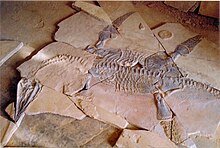| Mauriciosaurus Temporal range: Early Turonian
~ | |
|---|---|

| |
| Holotype fossil of Mauriciosaurus fernandezi | |
| Scientific classification | |
| Domain: | Eukaryota |
| Kingdom: | Animalia |
| Phylum: | Chordata |
| Class: | Reptilia |
| Superorder: | †Sauropterygia |
| Order: | †Plesiosauria |
| Family: | †Polycotylidae |
| Genus: | †Mauriciosaurus Frey et al., 2017 |
| Type species | |
| Mauriciosaurus fernandezi Frey et al., 2017
| |
Mauriciosaurus (meaning "Mauricio [Fernández Garza's] reptile") is a genus of polycotylid plesiosaur from the Late Cretaceous of Mexico. It contains a single species, M. fernandezi (also named after Fernández Garza), described in 2017 by Eberhard Frey and colleagues from a single well-preserved juvenile specimen about 1.9 metres (6 ft 3 in) long. Morphologically, it is overall most similar to the polycotyline polycotylids Trinacromerum and Dolichorhynchops. However, several features separate Mauriciosaurus from all other polycotylids, warranting the naming of a new genus. These include the sophisticated pattern of ridges on the bottom of the parasphenoid bone on its palate; the narrow openings in the palate bordered by the pterygoid bones; the lack of perforations in the surface of the coracoid; and the highly unusual arrangement of gastralia, or belly ribs, which is only otherwise seen in the non-polycotylid Cryptoclidus.
Partially as a consequence of the oxygen-poor environment that the specimen was preserved in, the type specimen Mauriciosaurus is notable for possessing well-preserved soft-tissues. In life, each of its four flippers bore a flexible trailing edge such that they formed hydrofoils, and contour fat created a drop-like outline of the body by merging the torso and immobile tail into a single unit. Both of these soft-tissue traits would have improved the animal's hydrodynamic performance, making it a fast swimmer comparable to modern leatherback sea turtles. Additionally, a heavily-pigmented lining protected the organs of the body cavity from UV exposure. After death, the sediment allowed the contour fat to preserve into adipocere instead of putrefying, which preserved most of the epidermal soft tissue save for that of the belly.
The oxygen-poor deposits that Mauriciosaurus was preserved in, collectively known as the Vallecillo plattenkalk, would have represented the bottom of a continental shelf about 500 kilometres (310 mi) offshore in the prehistoric Gulf of Mexico. Inoceramid bivalves represent the only endemic benthic fauna at the site; other fossil organisms known from Vallecillo include invertebrates such as ammonites and barnacles that grew on those ammonites, as well as vertebrates consisting of various fish, aigialosaurid mosasaurs, and turtles. The type specimen of Mauriciosaurus is associated with an ammonite, Mammites nodosoides, which is present only in the Turonian interval of the Vallecillo deposits, allowing it to be dated to that age.